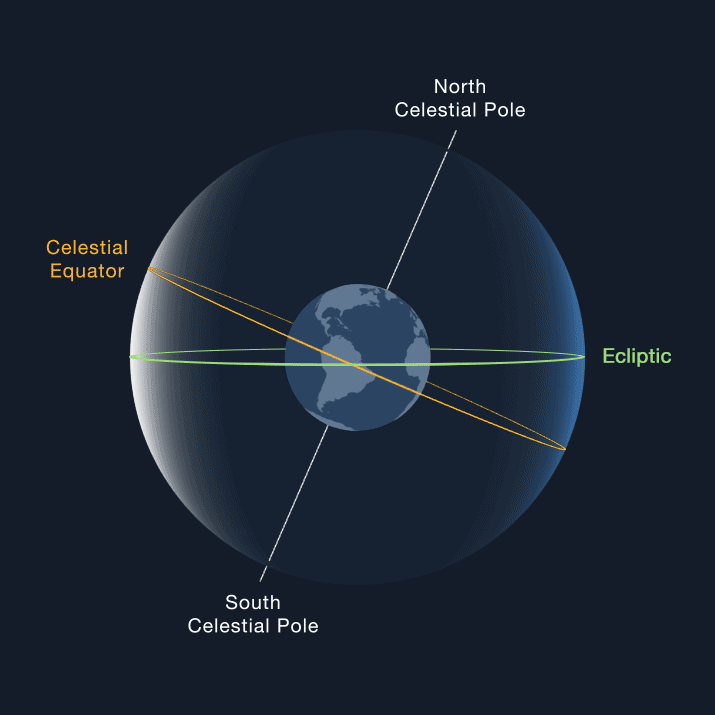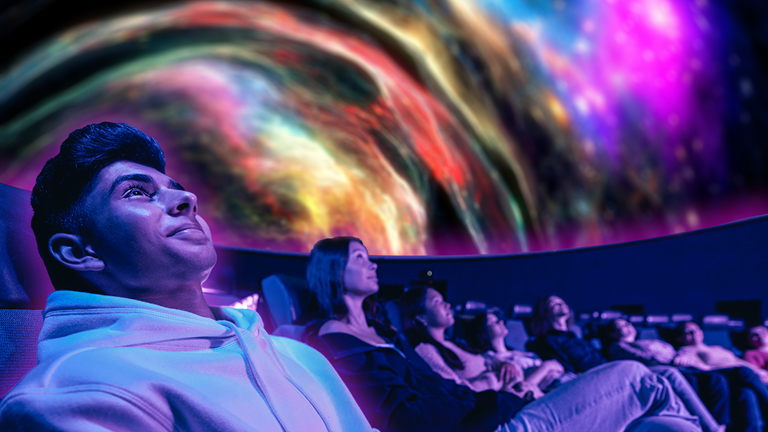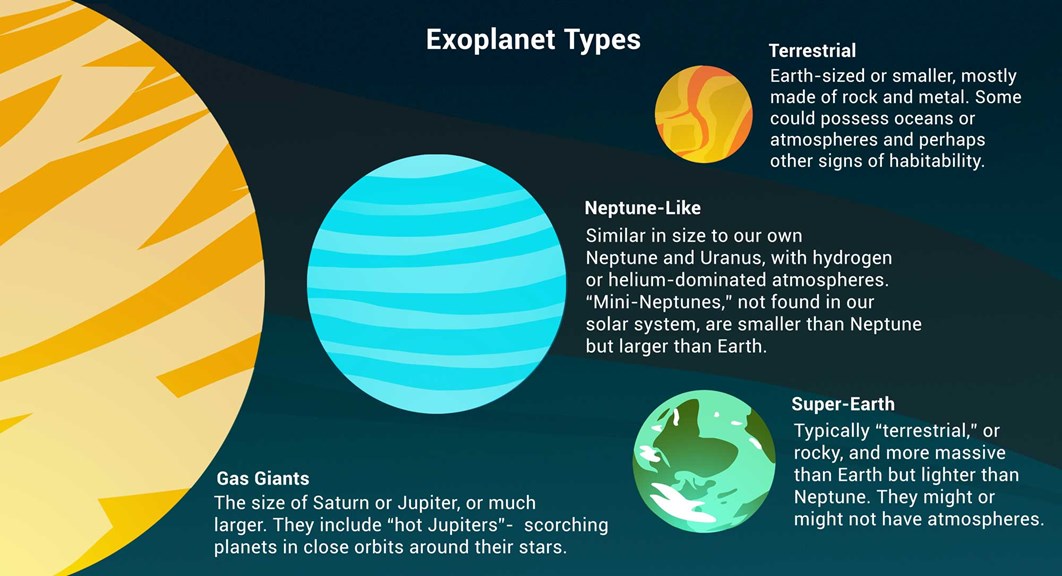Skynotes: April 2022
Upcoming events
Exoplanets in abundance
Just announced by NASA is a new tally of 5000 planets around other stars, and the count continues! Enjoy the latest news, videos and related pages about the search for alien worlds on their Exoplanet Exploration page.
One extraordinary example is WASP-121b, a 'hot Jupiter' that orbits very close to its parent star. It gives evidence for a water cycle, clouds of metal, atmospheric temperatures from 1500 to 3000 degrees Celsius, and winds that sweep from dayside to nightside of this tidally-locked planet. See Alien Weather of WASP-121b.
Melbourne Sun times*
| Date | Rise | Set | Day length | Solar noon§ |
|---|---|---|---|---|
| Fri 1st | 7:33 | 7:14 | 11:40 hrs | 1:24 |
| Mon 11th | 6:42 | 5:59 | 11:16 hrs | 12:21 |
| Thu 21st | 6:51 | 5:45 | 10:53 hrs | 12:18 |
| Sat 30th | 6:59 | 5:34 | 10:34 hrs | 12:17 |
* Daylight Savings ends 3am, Sunday 3 April, with clocks turned back 1 hour.
§ When the sun is at its highest, crossing the meridian or local longitude.
Moon phases
| Phase | Date |
|---|---|
| New Moon | Fri 1st |
| First Quarter | Sat 9th |
| Full Moon | Sun 17th |
| Third Quarter | Sat 23rd |
Moon distances
Fri 8th is lunar apogee (furthest from Earth) at 404,268 km.
Wed 20th is lunar perigee (nearest to Earth) at 365,143 km.
Our receding Moon and slowing Earth
While the average Earth-Moon distance is 385,000 km, our natural satellite has a 28-day elliptical orbit which varies its distance by about 50,200 km. If converted to a measurement based on the speed of light, the moon lies a little over 1 light second away. Its moonshine reaches us in about a second.
Over time, however, the moon is moving away from Earth by 3-4 cm per year. This has been confirmed by use of the Apollo-era retro-reflective mirror arrays left on the lunar surface. 50 years of precision measurements have been made to determine the moon’s rate of recession.
The cause is gravitational tidal interactions between Earth and Moon which slows our planet’s rate of spin. Some of its angular momentum (or rotational energy) transfers to the moon which enlarges its orbit thereby increasing its distance from us. Over billions of years this process has already moved the moon away and slowed its spin so that only one side now faces Earth. The moon’s orbit and rotation are equal, both taking 28 days.
If Earth and Moon remain in existence long enough, then this process is expected to end when both bodies become mutually tidally locked with equal spins rates – the distance between them will become fixed with the same sides of Earth and Moon facing each other forever. A slower spinning Earth will, of course, mean a much longer day in that far future era.

Image NASA/Goddard/University of Arizona
The moon is 30 Earth diameters away, but for easy comparison consider the Earth a basketball and the moon a tennis ball with them placed seven metres apart.
A small effect of our moon drawing away is that its angular diameter will reduce - in the skies it will look smaller and smaller. At some point in time it will no longer cover the Sun and the extraordinary phenomenon of total solar eclipses will no longer occur. If intelligent beings are on Earth in 600 million years then presumably there will be a final solar eclipse to experience.
How long to get to the moon?
A trip to the moon is often said to take three days by spacecraft but that will depend on the path or trajectory taken, the speed of the craft, and whether it is to enter lunar orbit, do a direct (crash) landing, or do a fly-by of the moon. Apollo 16 astronauts in 1972 took three days and a little over two hours to reach lunar orbit, but later probes have been faster or slower depending on their mission.
The fastest trip so far was NASA’s New Horizons probe in 2006 which crossed the moon’s orbit eight and a half hours after its launch to Pluto. The slowest was the European SMART-1 probe in 2003 that took one year and six weeks using a highly efficient xenon-ion engine.
For more on the Earth-Moon system:
Planets
Mercury has recently completed a pass behind the Sun but is too close to be seen this month.
Venus is the bright ‘morning star’ again this month rising around 2am in the north-east before fading in the dawn light.
Earth passed the Autumn equinox last month. As we move towards mid-year our planet’s axis of rotation (tilted at a fixed angle of 23.5 degrees with respect to Earth’s orbit) will progressively lean the southern hemisphere away from the Sun until once more we slip into winter.
Mars is visible near bright Venus in the north-eastern skies rising from 3am before it too is lost in the early morning light.
Jupiter is bright and clear from around 3am in the east after which it will be lost in the dawn light.
Saturn precedes Jupiter rising around 12.30am in the north-east. Fainter with a slight yellow tinge it will remain visible until lost in very early morning light.
Meteors
April's main shower, The Lyrids, is centred near the bright star Vega low in the north at 3am. It is active from 16th-25th peaking on the 22nd-23rd. Better placed is the Pi-Puppids associated with Comet Grigg-Skjellerup which peaks on 24th centred low in the south-west near Canopus in Carina.
Stars and constellations
In the south
The Southern Cross can be found on its side in the south-east with the Two Pointers below. To the right of the Cross, in the south-western sky, is the star Canopus, the second brightest star in the night sky. Low in the south is Achernar, the head of the river Eridanus. Achernar never sets in Melbourne and is called a circumpolar star as it moves through a half-circle around the South Celestial Pole during the night as Earth rotates on its axis.
Also circumpolar are the stars of the Southern Cross and the Two Pointers (Alpha and Beta Centauri, the brightest and second brightest stars in Centaurus, the mythical centaur). From southern Australia and weather permitting, you can observe these stars every hour of the night on every night of the year.
Why circumpolar?
The term circumpolar is from the Latin circum meaning ‘round about’ or ‘around’ hence circumference, circumnavigate or circumscribe.
As Earth rotates these stars complete a circular path every 24 hours around the South Celestial Pole (SCP). This is the point in the sky we imagine the axis of the Earth, extending from the south pole, points to in space. If you were at the South Pole that would be above your head at the zenith. However, in Melbourne the SCP is offset in our sky to a point ~38 degrees above the southern horizon.

Circumpolar stars traverse our sky at night when they are visible and then complete their circuit during daytime when they are not visible. As our side of Earth turns away from the sun in an easterly direction (giving us local sunset), with dusk fading into twilight and then full night, we see stars move from east to west, along with any visible planets and the moon too if above the horizon.
With our planet rotating in an easterly direction these all move in the opposite direction in a westerly direction. Stars that are not circumpolar rise or set at some stage during the night but circumpolar stars being close to the SCP never rise or set - they remain above the horizon at a times. In the southern hemisphere if you look south you see these stars move clockwise around the sky during the night.
Find out more:
Returning to April’s night sky…
In the south-west, if you are away from bright city lights, you can see the Large and Small Clouds of Magellan, two small neighbouring galaxies to our own Milky Way. They appear as irregular fuzzy patches isolated away from the broad band of stars that runs south-east to north-west which is our inside edge-on view of our own galaxy.
In less light-polluted skies you can easily see in the Milky Way several dark regions that are vast clouds of dust. Whilst we may see a few foreground stars, the dark areas behind obscure our view of more distant stars of the galaxy. The obvious dark one adjacent to the Cross is the Coal Sack.
In the west
Orion, the hunter, is in the west lying almost on his side with the red-giant star Betelgeuse as one of his shoulders. The three bright stars that form an obvious line are Alnitak, Alnilam and Mintaka. They mark his belt and also conveniently the base of the local ‘Saucepan’ asterism. The handle of the saucepan is Orion’s scabbard which hangs from his belt. Continuing the belt stars above and a little to the right we reach Sirius, the brightest star in the night sky and principal star in Canis Major (greater or larger dog) which is one of Orion’s hunting dogs. Below Sirius in the north-west is Procyon which marks the position of his lesser or smaller dog Canis Minor.
Below Orion and drawing closer to the horizon during the month is the Hyades, an open group of stars that form a sideways wedge or V. This is the triangular head of Taurus, the bull, with his ‘angry eye’ as the red-giant star Aldebaran on the corner.
In the north
In the north but upside down from our southern hemisphere perspective is Leo, the lion. This constellation is easily recognised by the hook shape (or inverted backwards question mark) of stars that forms the mane on the lion’s head and shoulders.
To the left of Leo and close together are the two bright stars Castor and Pollux, the principal stars in the constellation of Gemini, the twins which appears upside down as well from southern latitudes.
In the east
Later this month and into May the spectacular constellation of Scorpius will begin its return to our evening skies. This is one of the largest constellations and when it appears low in the east you can easily identify to the left its long curving tail leading to its body containing the red-giant star Antares marking its heart, and to the right its pincers reaching out.
International Space Station
ISS orbits every 90 minutes at an average distance of 400 km appearing like a bright star moving slowly across the night sky. Here are some of the brightest passes expected this month over Melbourne and Central Victoria:
Morning
Sun 10th 5:50am-5:56am, West-South-West to North-East.
Mon 11th 5:04am-5:08am, South-South-West to North-East.
Evening
Mon 18th 7:20pm-7:24pm, North-West to South-South-East.
Tue 19th 6:32pm-6:38pm, North-West to East-South-East.
Heavens Above gives predictions for visible passes of space stations and major satellites, live sky views and 3D visualisations. Be sure to first enter your location under ‘Configuration’.
On this day
1st 1948, Alpha, Bethe and Gamow publish their famous paper on the ‘hot Big Bang’.
2nd 1845, Fizeau and Foucault take the first photograph of the Sun.
3rd 1966, Luna 10 (USSR) became the first spacecraft to orbit the Moon.
6th 1973, Pioneer 11 (USA) probe launched to Jupiter and Saturn.
8th 1732, birth of David Rittenhouse who determined Earth-Sun distance of 150 million km.
9th 1959, NASA’s first cohort of astronauts, “the Mercury 7”, are announced.
11th 1905, Einstein’s ‘Special Theory of Relativity’ is published.
11th 1970, Apollo13 (USA) was launched on its ill-fated mission.
12th 1633, Galileo’s trial by the Catholic Inquisition, on the question of a sun-centred solar system, begins in Rome.
12th 1961, Yuri Gagarin (USSR) became the first human in space orbiting Earth for 108 minutes in Vostok 1.
12th 1981, Columbia (USA) was the first space shuttle to be launched.
14th 1629, birth of Christiaan Huygens who explained Saturn’s rings and discovered its largest moon Titan.
16th 1495, birth of Petrus Apianus who established that cometary tails at all times point away from the Sun.
18th 1971, Salyut 1 (USSR), the first space station, was launched.
19th 1975, first Indian satellite, Aryabhata, is launched.
21st 1990, the Hubble Space Telescope (HST) was launched on the space shuttle Discovery.
23rd 1992, COBE satellite reveals microwave temperature variation across universe.
27th 2002, final telemetry received from probe Pioneer 10 (USA).
28th 1900, birth of Dutch astronomer Jan Oort whose name is given to a vast cloud of icy objects thought to orbit the sun well beyond the Kuiper Belt.
28th 2001, American Dennis Tito became first space tourist paying the Russian Space Agency $US20 million to travel on a Soyuz craft to the ISS for an 8 day journey.
30th 1006, brightest supernova ever recorded is seen in the constellation of Lupus.

